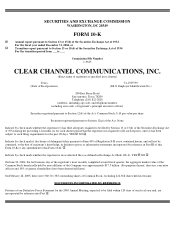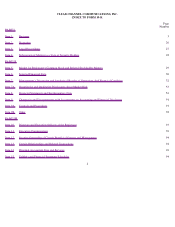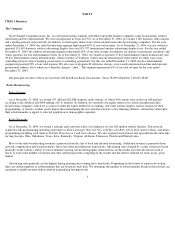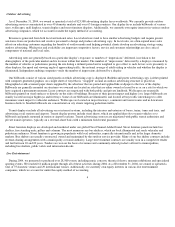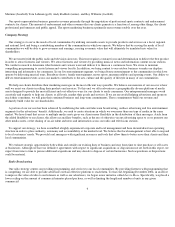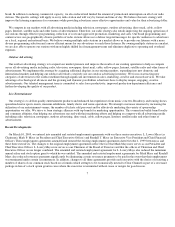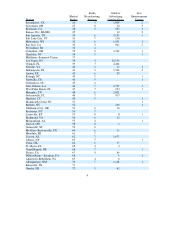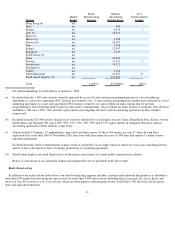iHeartMedia 2004 Annual Report Download - page 6
Download and view the complete annual report
Please find page 6 of the 2004 iHeartMedia annual report below. You can navigate through the pages in the report by either clicking on the pages listed below, or by using the keyword search tool below to find specific information within the annual report.
Martinez (baseball), Tom Lehman (golf), Andy Roddick (tennis), and Roy Williams (football).
Our sports representation business generates revenue primarily through the negotiation of professional sports contracts and endorsement
contracts for clients. The amount of endorsement and other revenues that our clients generate is a function of, among other things, the clients’
professional performances and public appeal. The sports marketing businesses primarily earn revenue ratably over the year.
Company Strategy
Our strategy is to serve the needs of local communities by utilizing our media assets to provide products and services on a local, regional
and national level and being a contributing member of the communities in which we operate. We believe that by serving the needs of local
communities we will be able to grow revenues and earnings, creating economic value that will ultimately be translated into value for
shareholders.
We are trusted with the public radio and television airwaves. This trust requires constant focus and determination to deliver the best product
in order to attract listeners and viewers. We attract listeners and viewers by providing musical, news and information content on our stations.
We conduct research to determine what listeners and viewers want and deliver it to them on a continuous basis. We strive to maintain
compelling programming to create listener and viewer loyalty. In addition, we bring content to our outdoor business to make our displays
interesting and informative for consumers. In our live entertainment segment, we bring diverse entertainment to the communities in which we
operate by delivering musical tours, Broadway shows, family entertainment, motor sports, museum exhibits and sporting events. Our ability to
deliver entertainment events across our markets contributes to the arts, culture and the quality of lifestyle in many of our communities.
We help our clients distribute their marketing messages in the most efficient ways possible. We believe one measure of our success is how
well we assist our clients in selling their products and services. To this end, we offer advertisers a geographically diverse platform of media
assets designed to provide the most efficient and cost-effective ways for our clients to reach consumers. Our entrepreneurial managers work
creatively and expertly to help our clients, at all levels, market their goods and services. If we are successful helping advertisers and sponsors
reach their consumers, we will gain their continued business and long-term commitments. Those commitments build our revenue and
ultimately build value for our shareholders.
A portion of our success has been achieved by mobilizing the radio and television broadcasting, outdoor advertising and live entertainment
segments for the advertisers’ benefit. Additionally, we seek to create situations in which we own more than one type of media in the same
market. We have found that access to multiple media assets gives our clients more flexibility in the distribution of their messages. Aside from
the added flexibility to our clients, this allows us ancillary benefits, such as the use of otherwise vacant advertising space to cross promote our
other media assets, or the sharing of on-air talent and news and information across our radio and televisions stations.
To support our strategy, we have assembled a highly experienced corporate and local management and have decentralized our operating
structure in order to place authority, autonomy and accountability at the market level. We believe that local management is best able to respond
to local customers’ needs. We provide local managers with significant resources and tools that allow them to better serve their clients and their
local communities.
We evaluate strategic opportunities both within and outside our existing lines of business and may from time to time purchase or sell assets
or businesses. Although we have no definitive agreements with respect to significant acquisitions or dispositions not set forth in this report, we
expect from time to time to pursue additional acquisitions and may decide to dispose of certain businesses. Such acquisitions or dispositions
could be material.
Radio Broadcasting
Our radio strategy centers on providing programming and services to our local communities. By providing listeners with programming that
is compelling, we are able to provide advertisers with an effective platform to reach them. To that end, beginning December 2004, in an effort
to improve the value of radio to our listeners as well as our advertisers, we began a new initiative called Less is More. Specifically, we placed a
lower ceiling on the amount of commercial minutes played per hour, as well as limiting the length and number of units in any given
commercial
6

